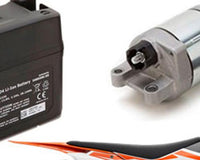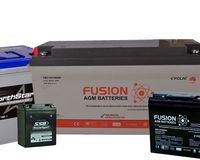This quick list sums up some of the most common phrases you will hear in battery specifications.
Amp Hour
Ampere Hour is short for ampere Hour, an ampere is a unit of measure of the rate of electron flow or current in an electrical conductor. An Amp hour refers to the amount of energy charge in a battery that will allow one Amp of current to flow for one hour.
We’ve covered Amp Hour more extensively in a previous post
CCA
A Cold Cranking Amp is a measure of how the battery holds up in cold conditions. The higher the CCA rating is, the better off your battery will be. This is important for people who live in colder climates, or people who are using the battery in a snowmobile.
We’ve covered CCA more extensively in a previous post.
Load
A load defines the current that is drawn from the battery. Internal battery resistance and depleting state-of-charge (SoC) cause the voltage to drop under load, triggering end of discharge. Power relates to current delivery measured in watts (W); energy is the physical work over time measured in watt-hours (Wh).
Terminal Voltage (V)
The voltage between the battery terminals with load applied. Terminal voltage varies with SOC and discharge/charge current
State of Health (SoH)
State of health is what the battery’s overall condition is, compared to its ideal conditions. Naturally, Soh does decrease over time with use, but modern, high-performance batteries are designed to maintain their SoH for long periods.
State of Charge (SoC)
State of charge is what the battery’s current level of charge is.
Cycle
One sequence of charge and discharge.
E.g. Charging a battery from 0% to 100% SoC is one cycle.
Cycle Life
Refers to the number of complete charge/discharge cycles that the battery is able to support before that its capacity falls under 80% of its original capacity. So, if the battery is discharged to 60 % and then charged to 80% it isn't a complete cycle.
Depth of Discharge (DOD)
The opposite of SoC, DOD is the percentage of battery capacity that has been discharged, expressed as a percentage of maximum capacity. A discharge to at least 80 per cent DOD is referred to as a deep discharge.
The DoD is the complement of SoC: as one increases, the other decreases.
Charge Current
The ideal current at which the battery is originally charged (to roughly 70 per cent SoC) under constant charging scheme before transitioning into constant voltage charging.
SLI
Starting, Lighting, Ignition.
A rechargeable, lead-acid battery that is typically used in automotive applications. The SLI powers these three featured in the vehicle.
Electrolyte
A chemical compound which, when fused or dissolved in certain solvents, usually water, will conduct an electric current. All electrolytes in the fused state or in solution give rise to ions which conduct the electric current.
Electrode
An electrode is an electrical conductor used to make contact with a non-metallic part of a circuit (e.g. a semiconductor, an electrolyte, a vacuum or air).









